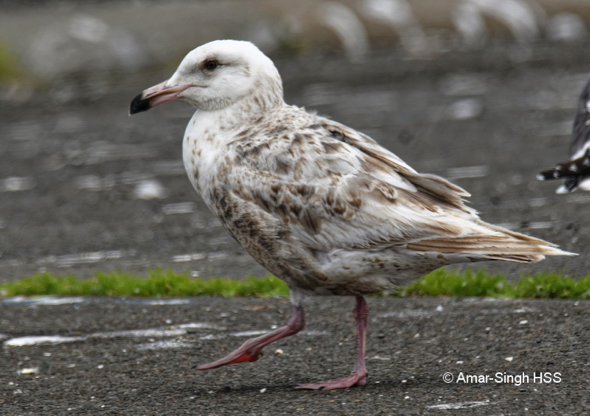“Slaty-backed Gulls (Larus schistisagus) were reasonably common and we had the opportunity to see young birds that had not attainted full adult plumage. I am attempting to age these birds but would appreciate any suggestions and even ID concerns (just in case these birds are not ID correctly and the possibility of hybrids).

“On the ‘surface’ all these three birds (#1-3) look like 1st summer birds. But I take into consider the wise words of Keith Vinicombe (2014) who, when making comments about moulting and aging of gulls, states ‘Each plumage is more adult-like than the previous but remember that the different plumages may vary individually, particularly in larger birds (such as Herring Gulls) so do not expect all birds to conform exactly to those illustrated in field guides. Bare parts too – eyes, bill and legs also change as a bird gets older and, although their progression is roughly in sync with their plumages, there is great individual variation in the acquisition of bare-part colours.’ Moores (2005) states ‘some First-Winter (and First-summer/early Second-winter) Slaty-backed Gull can, however, be very much more difficult to identify than older birds’.

“From various references, the key features of 1st summer birds are the black bill, the black scales on the feet, the darker iris, blackish tail. Some authors say the iris turns paler but others (Moores 2005) suggest this only happens with second-winter onwards. Most suggest the bill is black but some (Oiseaux Birds, HBW) suggest the pinkish base of the bill may appear in the first year. Generally older birds are more ‘bleached’ with the tail remaining largely blackish (Moores 2005) until adulthood (white). I am uncertain when the adult reddish orbital ring develops. The yellow-orange bill colour change is said to only occur from third winter onwards.

“Bird #1 is clearly a 1st summer bird. Notice the near complete black bill, well shown black scales on the feet, the darker iris, black tail and overall darker wing and belly plumage.
Bird #2 is a bird with a black bill but the tail is much lighter and the overall plumage is also more bleached.
Bird #3 is a bird with pinkish base to the bill, lighter iris, browner tail, hardly any black scales on the feet and overall lighter plumage.
“Please note that I have more images of each bird (some in flight) to offer better views/descriptions. Despite the variation I am inclined to ‘label’ all as 1st summer birds but wonder if Bird #3 is of a second summer bird.”

Dato’ Dr Amar-Singh HSS
Ipoh, Perak, Malaysia
7th June 2019
Location: Nemuro Peninsula, East Hokkaidō, Japan
References:
1. Keith Vinicombe. The Helm Guide to Bird Identification. Bloomsbury. 2014.
2. Mark Brazil. Birds of Japan. Helm Field Guides 2018.
3. Nial Moores, Charlie Moores (2005). The identification of Slaty-backed Gull Larus schistisagus. Birds of Korea (available HERE).
4. Burger, J., Gochfeld, M., Garcia, E.F.J. & Kirwan, G.M. (2019). Slaty-backed Gull (Larus schistisagus). In: del Hoyo, J., Elliott, A., Sargatal, J., Christie, D.A. & de Juana, E. (eds.). Handbook of the Birds of the World Alive.
5. Gull Research Organisation. 30. Slaty-Backed Gull (available HERE).
6. Oiseaux Birds: Slaty-backed Gull – Larus schistisagus (available HERE).








